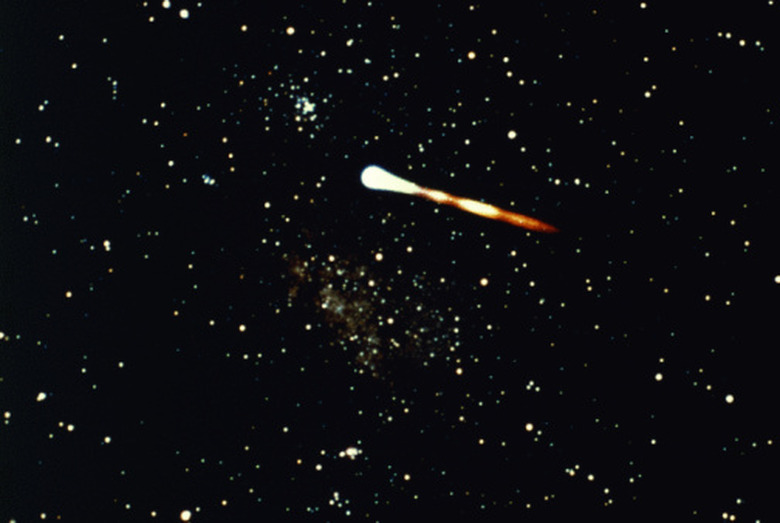What Are The Three Parts Of A Comet?
Astronomers have identified three main parts of a comet: the nucleus, coma and tail. The tail section is broken into three parts. Some comets, when combined with their tales, can be larger than the distance from the Earth to the sun, which is roughly 93 million miles.
Nucleus
Nucleus
Made up of ice, gas, rock and dust, the nucleus of a comet is located in the center of the head and is always frozen. The gaseous part of the nuclei is composed of carbon monoxide, carbon dioxide, methane and ammonia. The area usually encompasses 0.6 to 6 miles or more. Most of the comet's mass is located in the nucleus. The nuclei is known as one of the darkest objects in space.
Coma
Coma
The comet's coma is made up primarily of gas and encompasses the nucleus. The size is about 600,000 miles across. Carbon dioxide, ammonia, dust, water vapor and neutral gases make up the coma. Together with the nucleus, the coma forms the head of the comet. The coma is the most visible part of a comet.
Tail
Tail
Three tails either follow or guide the nucleus and coma. The ion, or plasma, tail is made up of charged ions that consistently face away from the sun due to solar winds. Because of this, the ion tail leads the comet away from the sun or it follows it towards the sun. The tail can be more than 60 million miles long.
The dust tail is long and wide. It is made up of microscopic dust particles that are buffeted by photons that the sun emits. Due to the comet's motion, the tail curves. As the comet moves away from the sun, the tail fades.
The envelope tail is composed of hydrogen gas and is usually located between the dust tail and ion tail. It is roughly 6 million miles across and 60 million miles long. The tail appears larger when it is near the sun.
Appearance
Appearance
Comets don't become round with their own gravity due to their limited size, so they will often have irregular shapes. Comets are visible from Earth when they pass through the inner solar system. They become more visible as they approach the brightness of the sun. The nucleus of a comet only reflects 4 percent of the sun's light, one of the lowest ratios known to man. Asphalt reflects roughly 7 percent.
Cite This Article
MLA
Chappell, Phillip. "What Are The Three Parts Of A Comet?" sciencing.com, https://www.sciencing.com/three-parts-comet-8119632/. 24 April 2017.
APA
Chappell, Phillip. (2017, April 24). What Are The Three Parts Of A Comet?. sciencing.com. Retrieved from https://www.sciencing.com/three-parts-comet-8119632/
Chicago
Chappell, Phillip. What Are The Three Parts Of A Comet? last modified March 24, 2022. https://www.sciencing.com/three-parts-comet-8119632/
